Proposed Flood Mitigation Using Backwater in Highly Developed Watersheds with Consideration of Crop Calendars and Spatial Resolution: Toward Consensus Formation
Abstract
1. Introduction
2. Outline of the Study Area
2.1. Jinzu River Basin
2.2. Land Improvement District
3. Research Methods
3.1. Numerical Experiment
3.2. Computational Conditions
3.3. Crop Calendar
4. Results and Discussion
4.1. Comparison of Elevation Data Products
4.2. Results of Numerical Experiments
4.3. Crop Calendar
5. Conclusions
Author Contributions
Funding
Data Availability Statement
Conflicts of Interest
References
- Ministry of Land, Infrastructure, Transport and Tourism. The Total Damage Cost Caused by the Water-Related Disasters in 2019, including the Typhoon Hagibis, Was the Highest Since the Start of the Statistical Records. Available online: https://www.mlit.go.jp/report/press/content/001396912.pdf (accessed on 28 September 2023). (In Japanese).
- Shimatani, Y.; Minagawa, T. From catchment based flood management to land restructuring. Adv. River Eng. 2021, 27, 575–578. (In Japanese) [Google Scholar]
- The Flood Hub, Natural Flood Management (NFM). Available online: https://thefloodhub.co.uk/nfm/ (accessed on 16 November 2023).
- Matsuno, Y.; Nakamura, K.; Masumoto, T.; Matsui, H.; Kato, T.; Sato, Y. Prospects for multifunctionality of paddy rice cultivation in Japan and other countries in monsoon Asia. Paddy Water Environ. 2006, 4, 189–197. (In Japanese) [Google Scholar] [CrossRef]
- Shimura, H. Evaluation of Flood Control Functions of Rice Paddies and Fields: Division of Flood Control Capacity Needed for National Land among Agricultural Land, Dams, and Forests. J. Agric. Eng. Soc. Jpn. 1982, 50, 25–29. (In Japanese) [Google Scholar]
- Hayashi, N. Relation between the Change of Land Use and Multi-Functional Roles of Agriculture and Forestry; Report No. Y11020; Central Research Institute of Electric Power Industry: Tokyo, Japan, 2012. (In Japanese) [Google Scholar]
- Kim, T.C.; Gim, U.S.; Kim, J.S.; Kim, D.S. The multi-functionality of paddy farming in Korea. Paddy Water Environ. 2006, 4, 169–179. [Google Scholar] [CrossRef]
- Huang, C.C.; Tsai, M.H.; Ho, Y.F.; Tan, C.H. Multifunctionality of paddy fields in Taiwan. Paddy Water Environ. 2006, 4, 199–204. [Google Scholar] [CrossRef]
- Hayase, Y. Evaluation of Paddy Field’s Functions for Flood Control and a Proposal of Their Enhancing Project. J. Agric. Eng. Soc. Jpn. 1994, 10, 943–948. (In Japanese) [Google Scholar]
- Ishikawa, T. Planned Inundation in Future Excess Floods. J. Jpn. Soc. Hydrol. Water Resour. 2020, 32, 263–270. (In Japanese) [Google Scholar]
- Satoh, M. Position and Role of Agricultural Land in the New Policy of Integrated Watershed Flood Management of Japan. J. Jpn. Soc. Hydrol. Water Resour. 2022, 35, 41–57. (In Japanese) [Google Scholar] [CrossRef]
- Ministry of Land, Infrastructure, Transport and Tourism. Manual for Flood Control Economic Surveys (Draft). Available online: https://www.mlit.go.jp/river/basic_info/seisaku_hyouka/gaiyou/hyouka/r204/chisui.pdf (accessed on 28 September 2023). (In Japanese).
- Minagawa, H.; Kitagawa, I.; Masumoto, T. Estimation Method of Flood Damage on Rice Paddies for Watershed Management as Flood Risk Mitigation. J. Jpn. Soc. Irrig. Drain. Rural Eng. 2016, 84, 271–279. (In Japanese) [Google Scholar]
- Sakagami, J.; Sone, C.; Nakazono, M. Injury to Rice Plants by Floods and Resistance to Submergence. Jpn. J. Crop Sci. 2012, 81, 1–9. (In Japanese) [Google Scholar] [CrossRef][Green Version]
- Ministry of Land, Infrastructure, Transport and Tourism. Jinzu River Basin Fundamental River Management Policy. Available online: https://www.mlit.go.jp/river/basic_info/jigyo_keikaku/gaiyou/seibi/zindu_index.html (accessed on 23 October 2023). (In Japanese).
- Toyama City, Toyama City Flood Hazard Map 2022. Available online: https://www.city.toyama.lg.jp/_res/projects/default_project/_page_/001/006/974/00_map3.pdf (accessed on 10 October 2023). (In Japanese).
- National Federation of Land Improvement Associations. What is Land Improvement? Available online: https://www.inakajin.or.jp/land-improvement (accessed on 28 September 2023). (In Japanese).
- Ministry of Land, Infrastructure, Transport and Tourism. Water Resources Utilization. Available online: https://www.mlit.go.jp/mizukokudo/mizsei/mizukokudo_mizsei_tk2_000014.html (accessed on 28 September 2023). (In Japanese).
- Ministry of Agriculture, Forestry and Fisheries. Characteristics of Japanese Irrigation and Recent Issues. Available online: https://www.maff.go.jp/j/nousin/keityo/mizu_sigen/pdf/panf05_j.pdf (accessed on 28 September 2023). (In Japanese).
- Ministry of Agriculture, Forestry and Fisheries, Water Rights for Agricultural Use. Available online: https://www.maff.go.jp/j/nousin/mizu/kurasi_agwater/k_agri/pdf/detail_jp.pdf (accessed on 28 September 2023). (In Japanese).
- Ministry of Agriculture, Forestry and Fisheries. Land Improvement Project Plan Design Standard Plan. Water for Agricultural Use (Paddy Field). Available online: https://www.maff.go.jp/j/nousin/noukan/tyotei/kizyun/pdf/00_yousui_suiden_gijutsusho_zentaiban.pdf (accessed on 28 September 2023). (In Japanese).
- Yamaguchi, S.; Muro, K.; Iwamura, K. Development of a flood simulator for a flood risk communication tool. Annu. J. Hydraul. Eng. 2005, 49, 421–426. (In Japanese) [Google Scholar] [CrossRef][Green Version]
- Toyama Prefecture, River Development Plan for the Left Bank Area of the Jinzu River System. Available online: https://www.pref.toyama.jp/documents/5164/01452229.pdf (accessed on 28 September 2023). (In Japanese).
- Japan Agricultural Cooperatives of Aoba, Aoba Rice Cultivation Calendar. Available online: https://ja-aoba.jp/archives/001/202302/令和5年産移植『コシヒカリ』.pdf (accessed on 28 September 2023). (In Japanese).
- Nippon Agricultural Research Institute. “Estimation Scale for Rice Flood Damage and Drought Loss” Survey Table; Nippon Agricultural Research Institute: Tokyo, Japan, 1956; p. 65. (In Japanese) [Google Scholar]
- Fukuoka, S.; Shimatani, Y.; Tamura, H.; Tomari, K.; Nakayama, M.; Takase, A. Field experiments on reed deformation and falling and roughness coefficient on floodchannel by flows. Adv. River Eng. 2010, 9, 219–224. (In Japanese) [Google Scholar]
- Minagawa, H.; Masumoto, T.; Horikawa, N.; Yoshida, T.; Kudo, R.; Kitagawa, I.; Zukemura, C. A pseudo-flooding experiment under real inundation conditions by using clean and turbid water plots to formulate reduction scales in rice yield. Tech. Rep. Natl. Inst. Rural Eng. 2013, 214, 111–121. (In Japanese) [Google Scholar]

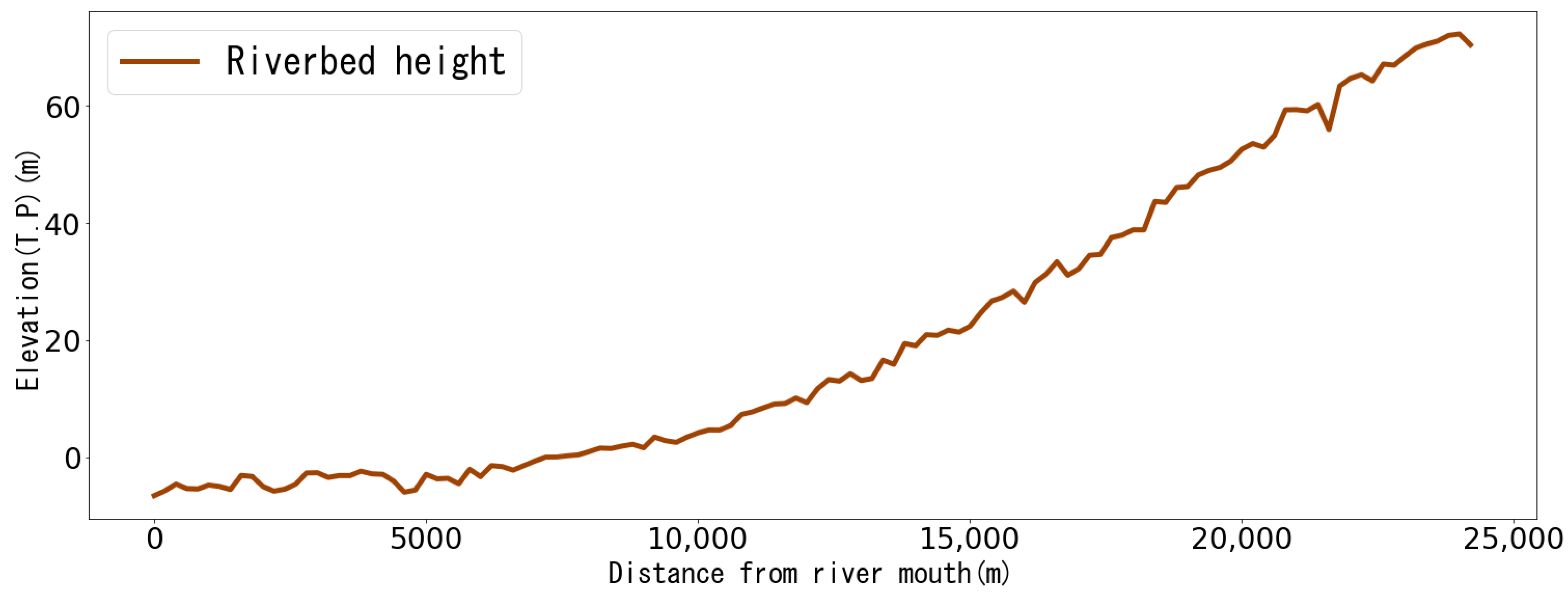

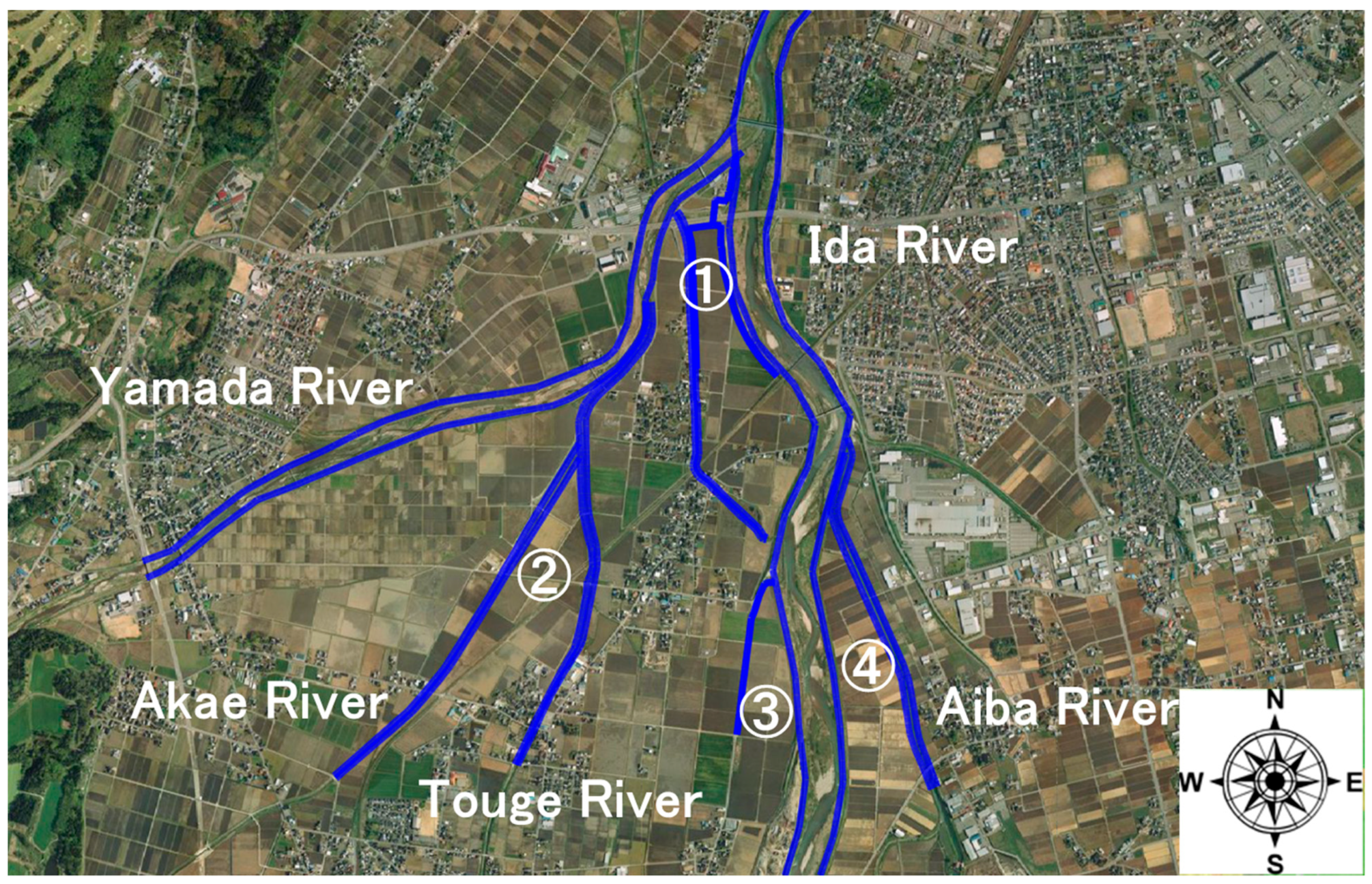
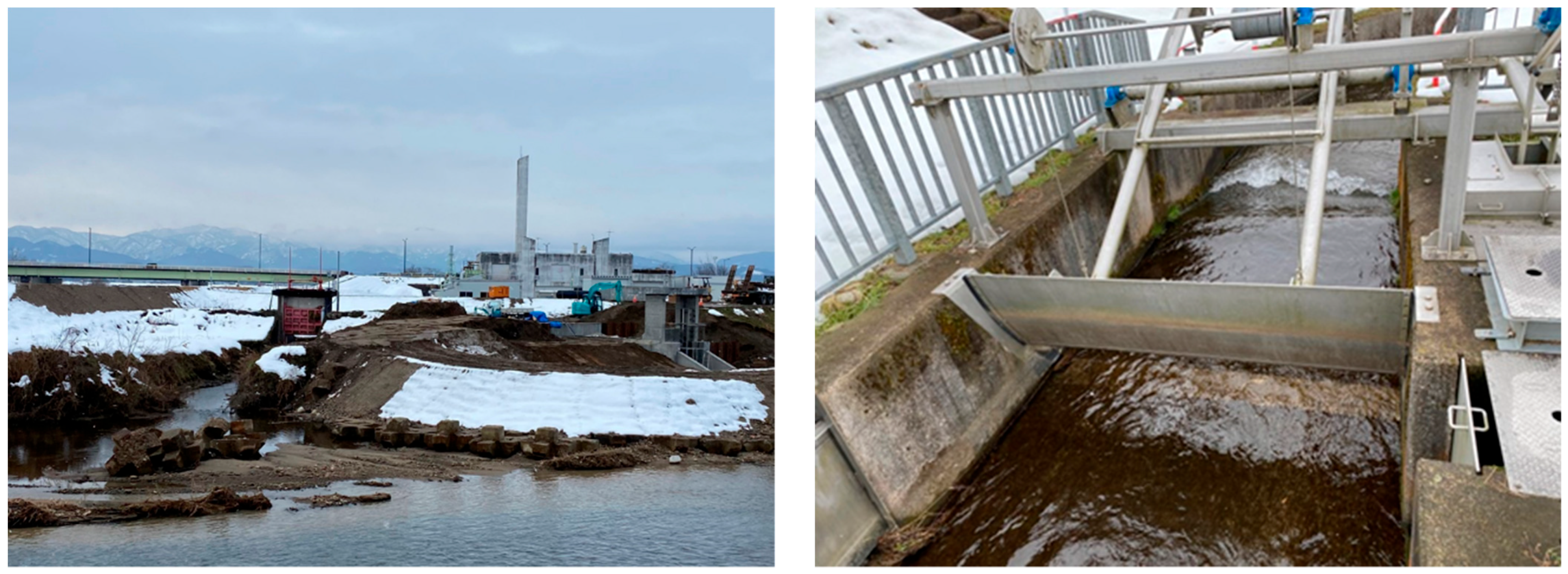
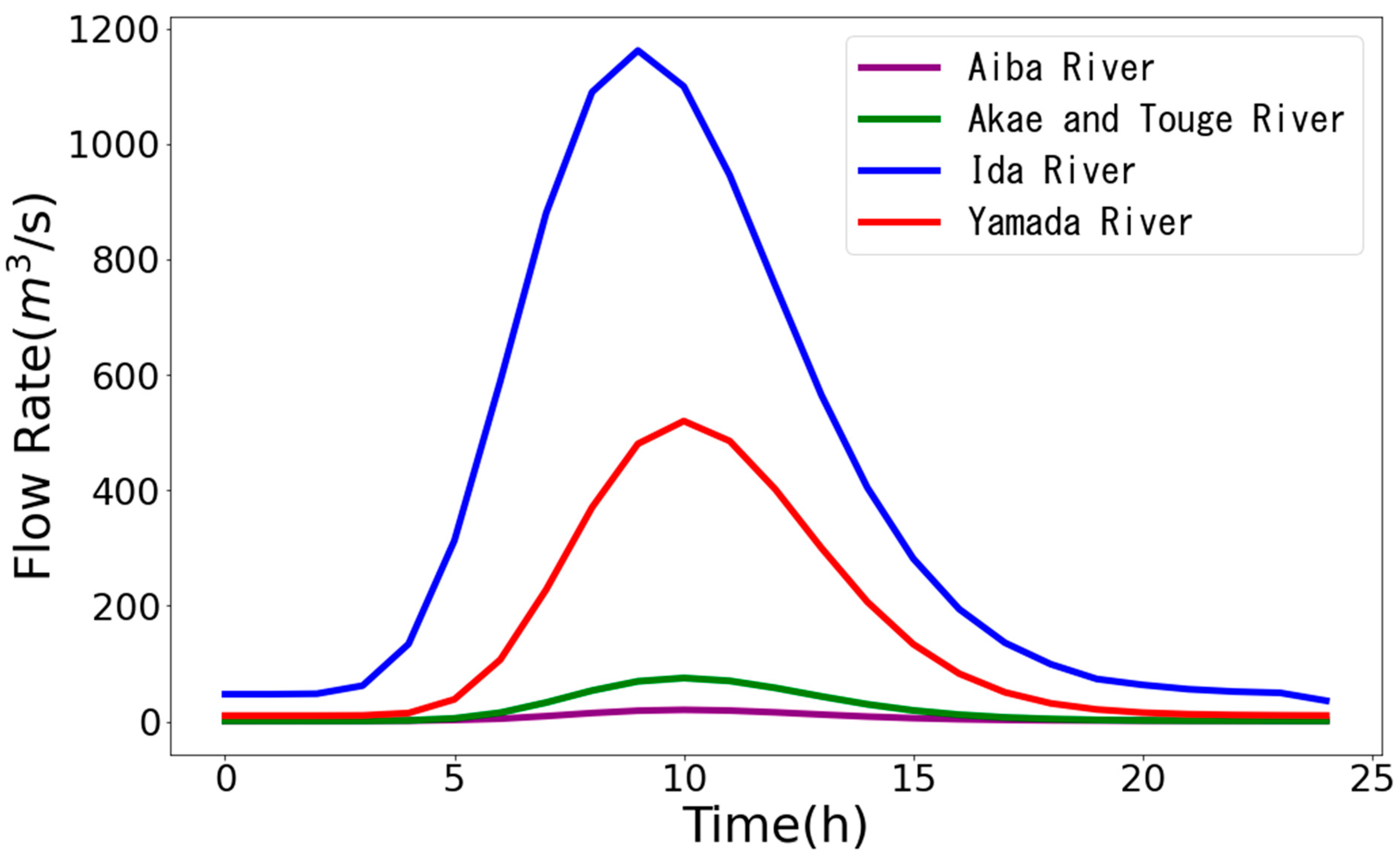
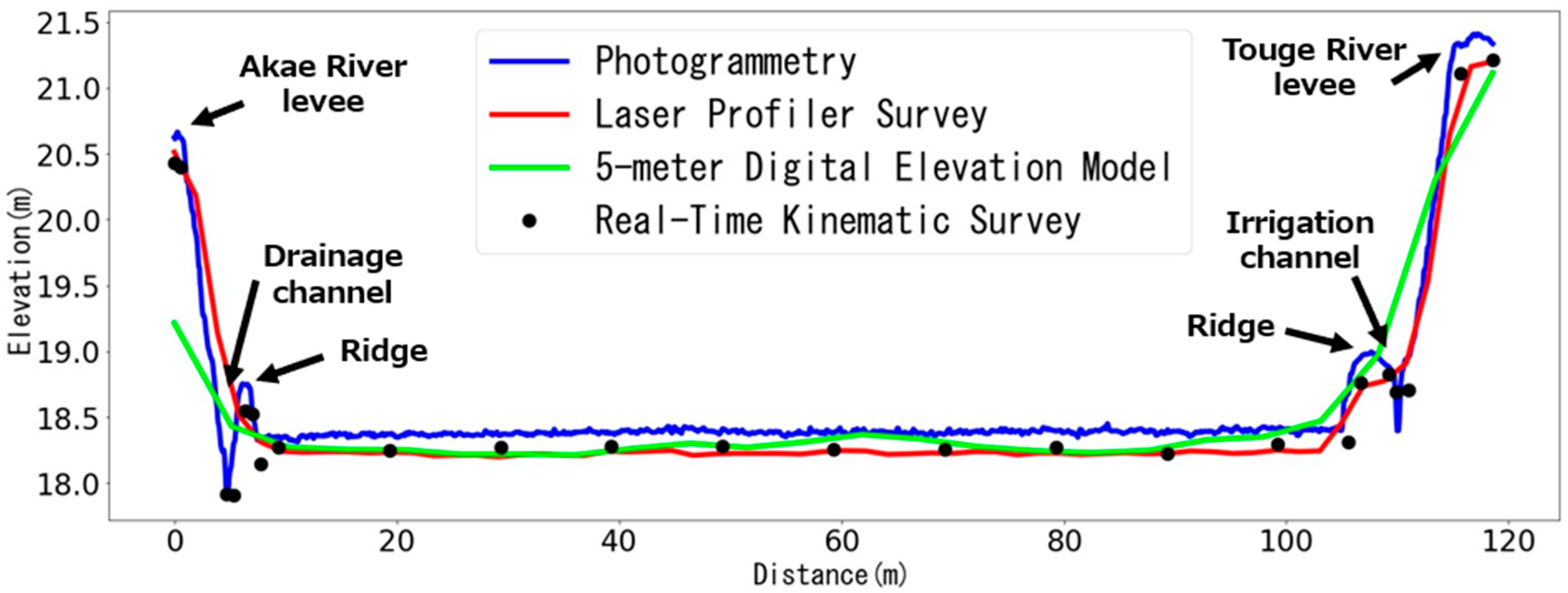
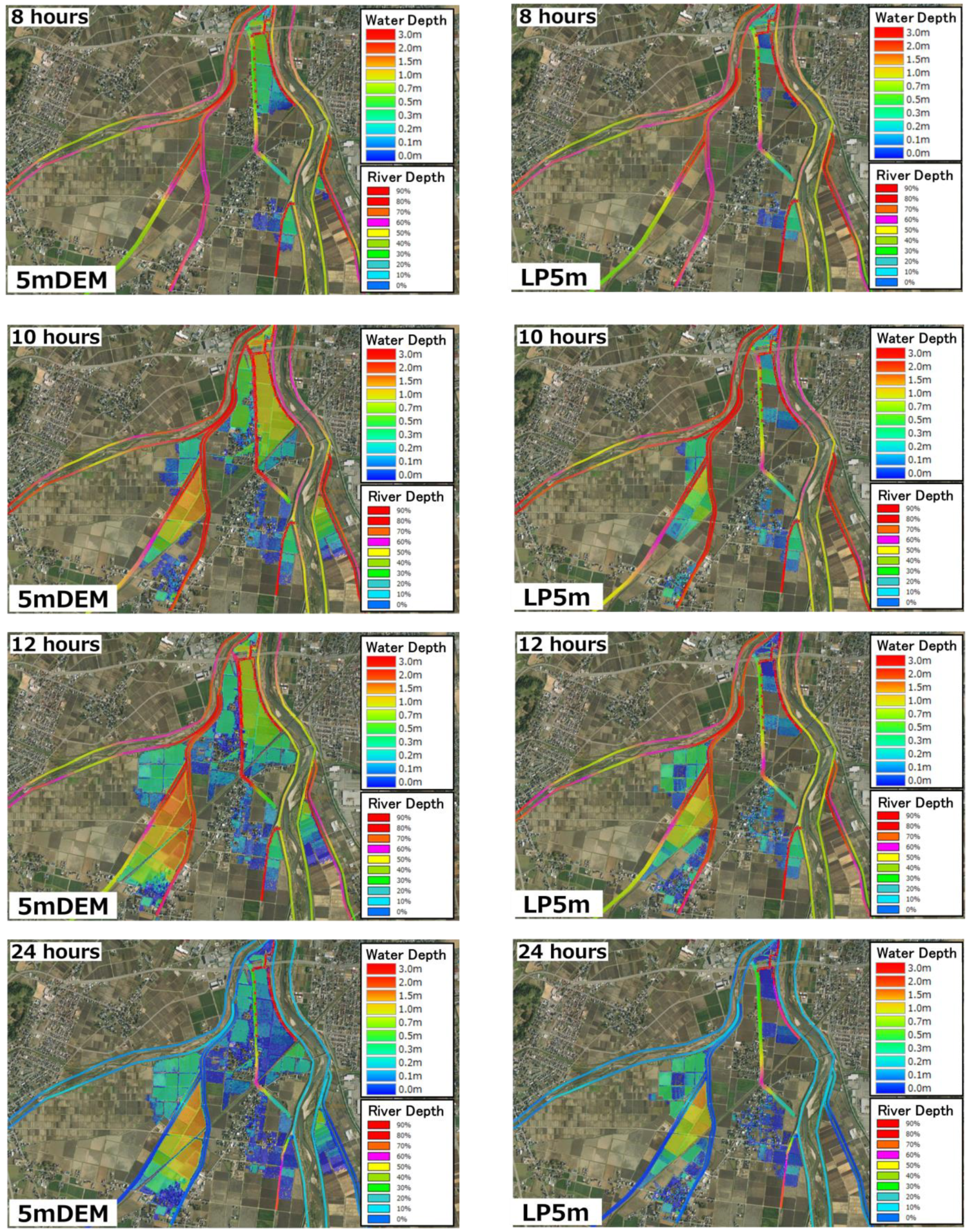

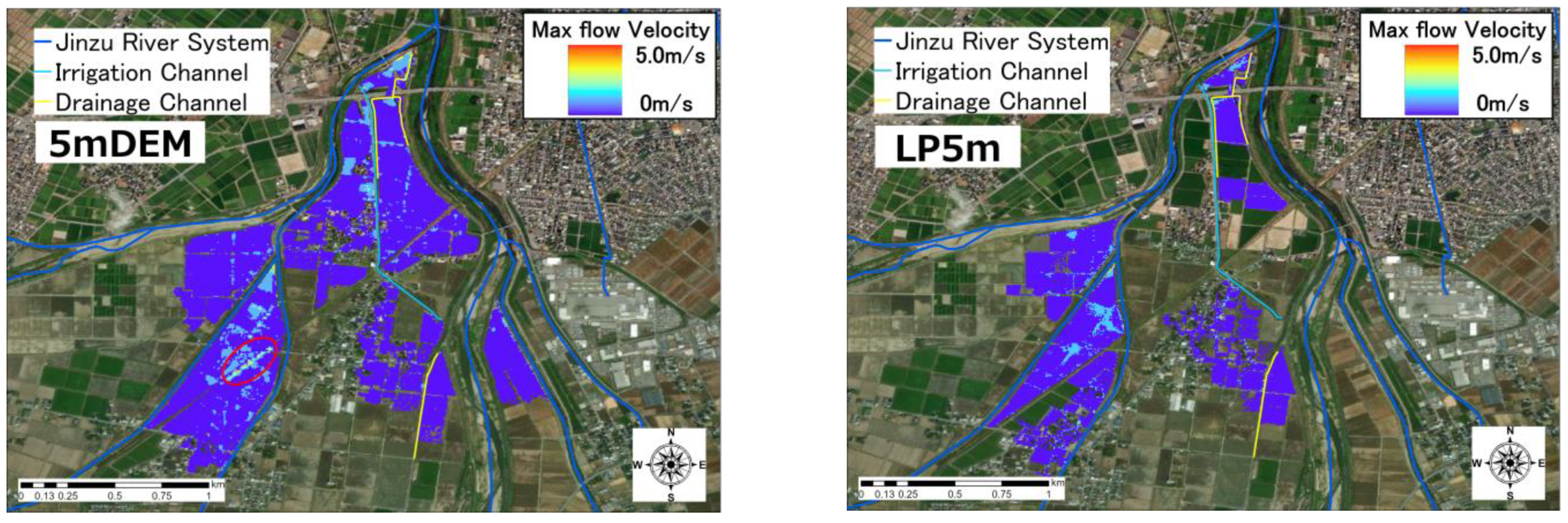
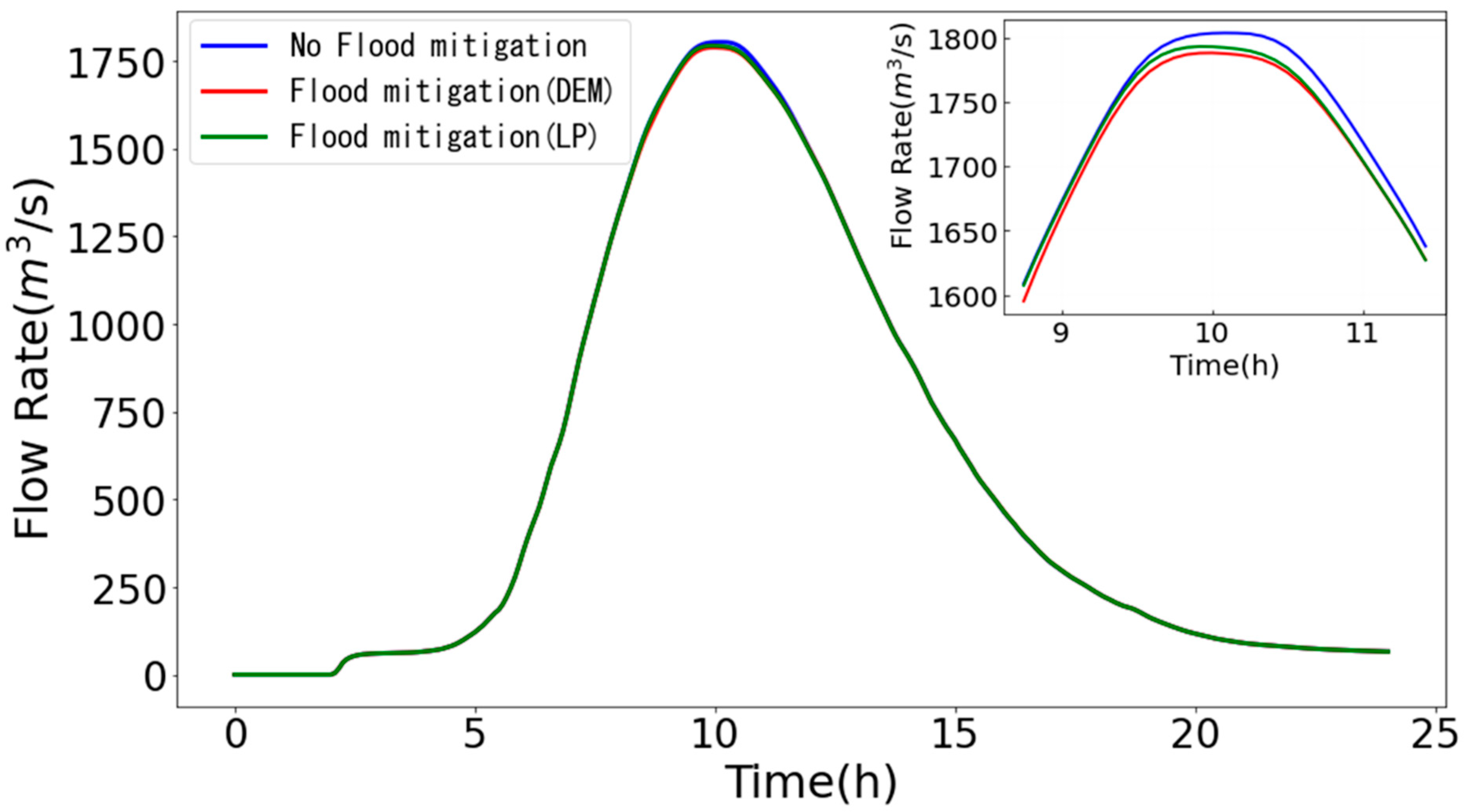
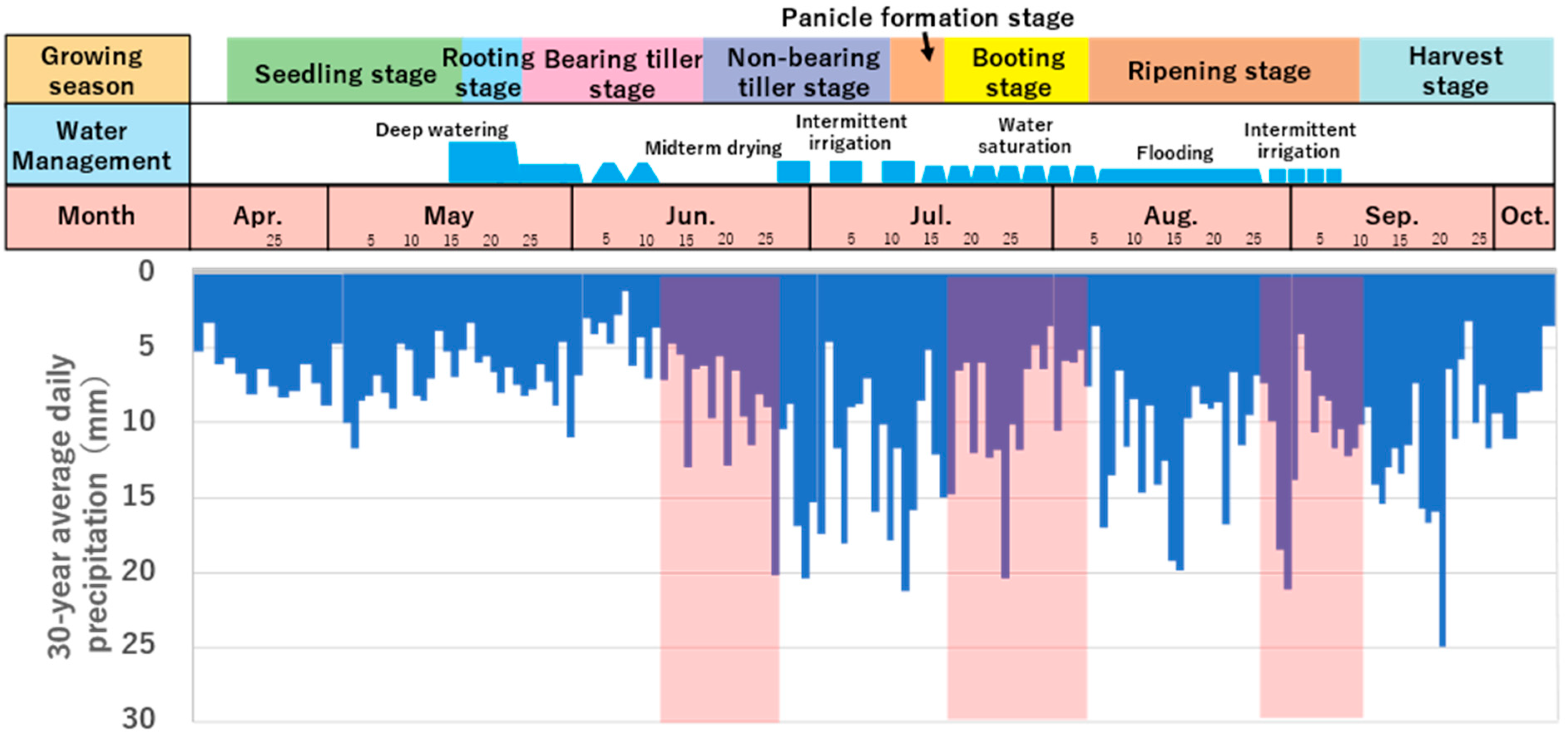
| Name | Source | Spatial Resolution |
|---|---|---|
| 5m Digital Elevation Model (5mDEM) | Geospatial Information Authority of Japan | About 5 m |
| Laser Profiler Survey | Toyama Prefecture | About 1 m |
| Photogrammetry | This research team | About 2 cm |
| Real-Time Kinematic Survey | This research team |
| River Name | Peak Flow Rate | Additional Information |
|---|---|---|
| Ida River | 1162.2 m3/s | Designed hydrograph |
| Yamada River | 520.0 m3/s | River Development Plan for the Left Bank Area of the Jinzu River System |
| Touge River | 75.0 m3/s | River Development Plan for the Left Bank Area of the Jinzu River System |
| Akae River | 75.0 m3/s | Full Capacity |
| Aiba River | 20.0 m3/s | Full Capacity |
| Irrigation and Drainage Channel | 0.1 m3/s~5.0 m3/s | Constant Flow Rate According to River Capacity |
Disclaimer/Publisher’s Note: The statements, opinions and data contained in all publications are solely those of the individual author(s) and contributor(s) and not of MDPI and/or the editor(s). MDPI and/or the editor(s) disclaim responsibility for any injury to people or property resulting from any ideas, methods, instructions or products referred to in the content. |
© 2023 by the authors. Licensee MDPI, Basel, Switzerland. This article is an open access article distributed under the terms and conditions of the Creative Commons Attribution (CC BY) license (https://creativecommons.org/licenses/by/4.0/).
Share and Cite
Ueno, Y.; Tebakari, T.; Noda, K.; Yoshimi, K. Proposed Flood Mitigation Using Backwater in Highly Developed Watersheds with Consideration of Crop Calendars and Spatial Resolution: Toward Consensus Formation. Water 2023, 15, 4139. https://doi.org/10.3390/w15234139
Ueno Y, Tebakari T, Noda K, Yoshimi K. Proposed Flood Mitigation Using Backwater in Highly Developed Watersheds with Consideration of Crop Calendars and Spatial Resolution: Toward Consensus Formation. Water. 2023; 15(23):4139. https://doi.org/10.3390/w15234139
Chicago/Turabian StyleUeno, Yohei, Taichi Tebakari, Keigo Noda, and Kazuhiro Yoshimi. 2023. "Proposed Flood Mitigation Using Backwater in Highly Developed Watersheds with Consideration of Crop Calendars and Spatial Resolution: Toward Consensus Formation" Water 15, no. 23: 4139. https://doi.org/10.3390/w15234139
APA StyleUeno, Y., Tebakari, T., Noda, K., & Yoshimi, K. (2023). Proposed Flood Mitigation Using Backwater in Highly Developed Watersheds with Consideration of Crop Calendars and Spatial Resolution: Toward Consensus Formation. Water, 15(23), 4139. https://doi.org/10.3390/w15234139







